|
JIMMA - The Capital of Kaffa Province & KAFFA - the "Botanical Homeland of COFFEE"
Jimma has been the capital city of Kaffa province and is situated in about 335
km south west of the Ethiopian capital, Addis Ababa. The Kaffa region is Ethiopia's largest producer of coffee, the most important
cash crop for Ethiopia and accounts for more than 60% of Ethiopia's export earnings and provides the primary source of income
for many thousands of small farmers.
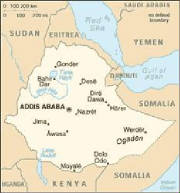
|
| Jimma: 335 km south west of Addis Ababa, Ethiopia |
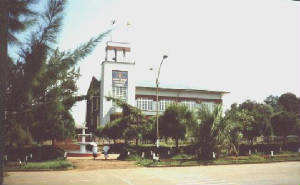
|
| The municipality building. Picture taken in 2001 |
Coffee has a long and revered history in Ethiopia and is an
important component of Ethiopian culture and society. The name coffee is even derived from the "Kaffa" after the discovery
of coffee in this region and later became known to the world. It is therefore, kaffa is known as the botanical homeland of
coffee. Jimma with a population of over 90,000 used to be called "Jimma, yewebet ketema", a city of beauty.
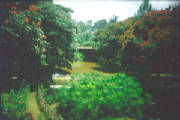
|
| The Awetu park in Jimma |
Jimma is the commercial centre for a coffee-producing region and was once the heart
of the famous Kingdom, the kingdom of Jimma Abba Jiffar, established about 1830, was the largest and most powerful of five
monarchies formed by the Oromo in the Gibe region of south western Ethiopia. The palace of Abba Jiffar still exists in Jimma
and is visited by tourists. Agricultural and Medical Universities that are affiliated to A.A. University are also located
in the city.
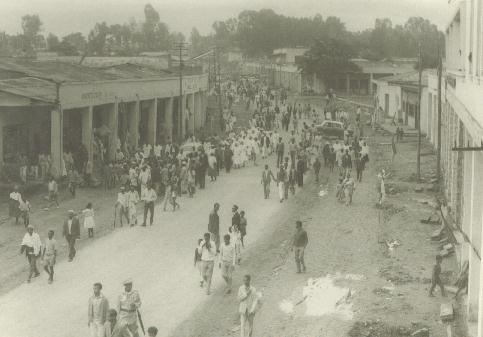
|
| "Ferenj arada" viewed from north. Picture taken in 1962 |
Kaffa province is one of the richest regions in the country with its diverse
languages, cultures, religions and traditions that coexisted for centuries. Kaffa is mainly an agricultural region with
the chief crops being Maize, Sorghum and Teff. Fruits, Banana and Pineapples are also important. Moreover, Potassium and sodium
nitrates are mined north east of Jimma.
"Coffee
is Ethiopia's Gift to the World"
Ethiopia is
the birthplace of coffee (not South America, which some believe). The indigenous coffee trees (the only native coffee trees
in the world) first grew in ancient "Abyssinia," present-day Ethiopia and these trees were first discovered blossoming in
"Kaffa" region. The word 'COFFEE' derives from Kaffa and the name Kaffa is inherited from the hieroglyphic nouns 'KA'
and 'AFA' into Oromfia and 'Kaficho'. 'KA' is the name of God. 'AFA' is the name of earth
and of all plants that grow on earth. So, the word 'KOFFEE' or COFFEE means 'the land or plant of God'. Today most Ethiopian languages use the
word 'bunn' ('bunna') to describe coffee, however in Sidama it is called 'tukke'. COFFEE is still referred by many as Coffea
arabica and it is because wild coffee plants were taken (Ca 1000-1600) from the plateaus of central Ethiopia, from its origin
to southern Arabia (to Yemen) and was cultivated since the 15th century.
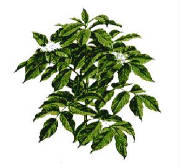
|
| The indigenous coffee tree. It can grow up to 2 meters |
A Brief History of Ethiopian Coffee
The Ethiopian nomadic mountain peoples
of the Oromo tribe have been the first to recognize coffee's sustaining effect (but not as a beverage). These people gathered
the coffee beans from the trees that grew in the region, ground them up and mixed them with animal fat, forming small balls
that they carried as rations on trips. Other indigenous tribes of Ethiopia ate the beans as porridge or drank a wine created
from the fermented crushed coffee beans.
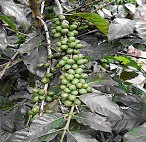
|
| Green (not ripen) coffee berries. |
Legends
have been adopted to explain the origins of coffee. They all have in common the fact that Ethiopia is heralded as that place
where coffee was first discovered. The most popular legend goes back to the 3rd century. Here it is said that a goatherd in
Ethiopias southwestern highlands, named Kaldi noticed to his amazement that after chewing the bright red berries from a tree
his goats pranced in an unusually frisky manner. Kaldi tried the berries and enjoyed their stimulating effect. A monk noticed
Kaldi and decided to try the berries with his friars. They all felt alert during their night prayers. As news of the stimulating
effect of the berry spread, people began chewing the berry before prayer, boiling it down to drink of 'white coffee', and
later roasting it to drink black coffee or to mix with butter to create a stimulating food. In the tenth century, coffee was
considered as food. By the 13th century, coffee's restorative
powers were well known in the Islamic world. The coffee beverage emerged when Arabians began roasting and grinding coffee
beans and drinking the hot beverage. Coffee was considered as a potent medicine, as well as a religious potion that helped
keep people wake during prayers.
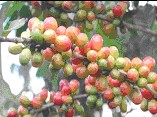
|
| Red & yellowish (ripen) coffee burries |
Pilgrims
of Islam spread the coffee throughout the Middle East by the end of the 15th century. Until the 17th century, Arabia supplied
the world's coffee through the port of Mocha, which became one of coffee's names. Then the Dutch introduced the plant into
Java, and the island quickly became synonymous with coffee. Coffee crossed to Europe with the first coffeehouses opening in
Vienna, Paris and London (1652) and to Latin America (Brazil) (Ca 1727 - 1800). Coffee drinking is an important social and
cultural tradition in Ethiopia and is practised with ritualised and elaborate ceremonies.
____________________________________________________________________________________
Copyright
© 2003 FMSSAS
All Rights Reserved
|

